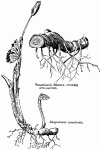Bloodroot. Sanguinaria canadensis L.
OTHER COMMON NAMES—Redroot, red puccoon, red Indian-paint, puccoon-root, coonroot, white puccoon, pauson, snakebite, sweet-slumber, tetterwort, tumeric.
HABITAT AND RANGE—Bloodroot is found in rich, open woods from Canada south to Florida and west to Arkansas and Nebraska.
DESCRIPTION OF PLANT —This indigenous plant is among the earliest of our spring flowers, the waxy-white blossom, enfolded by the grayish green leaf, usually making its appearance early in April. The stem and root contain a blood-red juice. Bloodroot is a perennial and belongs to the same family as the opium poppy, the Papaveraceae. Each bud on the thick, horizontal rootstock produces but a single leaf and a flowering scape, reaching about 6 inches in height. The plant is smooth and both stem and leaves, especially when young, present a grayish green appearance, being covered with a "bloom" such as is found on some fruits. The leaves are palmately 5 to 9 lobed, the lobes either cleft at the apex or having a wavy margin, and are borne on leaf stems about 5 to 14 inches long. After the plants have ceased flowering the leaves, at first only 3 inches long and 4 to 5 inches broad, continue to expand until they are about 4 to 7 inches long and 6 to 12 inches broad. The under side of the leaf is paler than the upper side and shows prominent veins. The flower measures about 1 inch across, is white, rather waxlike in appearance, with numerous golden-yellow stamens in the center. The petals soon fall off, and the oblong, narrow seed pod develops, attaining a length of about an inch.
DESCRIPTION OF ROOTSTOCK—When dug out of the ground Bloodroot is rather thick, round and fleshy, slightly curved at the ends, and contains a quantity of blood-red juice. It is from 1 to 4 inches in length, from one-half to 1 inch in thickness, externally reddish brown, internally a bright red blood color, and produces many thick, orange colored rootlets.
The rootstock shrinks considerably in drying, the outside turning dark brown and the inside orange-red or yellowish with numerous small red dots, and it breaks with a short, sharp fracture. It has but a slight odor and the taste is bitter and acrid and very persistent. The powdered root causes sneezing.
COLLECTION, PRICES AND USE—The rootstock should be collected in autumn, after the leaves have died, and after curing, it should be stored in a dry place, as it rapidly deteriorates if allowed to become moist. Age also impairs its activity. The price paid to collectors for this root ranges from about 5 to 10 cents per pound.
Bloodroot was well known to the American Indians, who used the red juice as a dye for skins and baskets and for painting their faces and bodies. It is official in the United States Pharmacopoeia and is used as a tonic, alterative, stimulant and emetic.
Ginseng and Other Medicinal Plants, 1936, was written by A. R. Harding.


